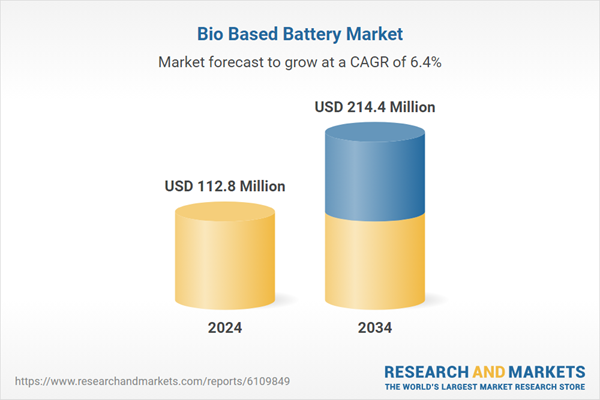As concerns intensify regarding hazardous waste disposal from traditional batteries, regulatory bodies are tightening their focus on sustainability, pushing manufacturers toward greener alternatives. One of the key regulatory shifts driving this transformation is the implementation of extended producer responsibility policies, which place the onus on manufacturers to manage the lifecycle of their products. These evolving compliance norms are compelling producers to adopt circular economic models, encouraging the use of recyclable and naturally sourced materials. Consequently, bio-based batteries are emerging as a viable solution for sectors aiming to transition toward cleaner energy while maintaining functionality and performance. The market’s growth is also supported by the increasing integration of bio-based components into flexible, portable, and wearable electronics - segments that demand non-toxic, compact, and high-performing energy sources.
The enzymatic bio-based battery segment is experiencing rapid advancements and is anticipated to surpass USD 80 million by 2034. These batteries are garnering industry attention due to innovations in enzyme technology and the incorporation of nanomaterial-enhanced electrodes, which significantly improve efficiency and energy density. The focus is now shifting toward improving the structural integrity and lifespan of these batteries to support their application across diverse platforms. Developers are prioritizing design adaptability and material innovation, which in turn is broadening the scope for deployment in next-generation energy systems. As enzymatic batteries continue to evolve, they are expected to become a key contributor to the expansion of the global bio-based energy ecosystem.
In terms of application, the healthcare industry accounts for a significant portion of market demand, holding a 31.6% share in 2024. Bio-based batteries are increasingly being tailored for use in medical devices, benefiting from materials such as magnesium, zinc, and biopolymers that support safe and flexible integration into wearable and implantable technologies. These materials allow for the creation of biocompatible energy solutions that can power low-voltage medical equipment without introducing harmful residues into the body or environment. The trend reflects a broader shift in healthcare toward sustainable innovations that improve patient safety while reducing environmental impact.
The United States remains a critical player in the development of bio-based battery technologies. The market in the country reached USD 21.5 million in 2024, up from USD 20.6 million in 2023 and USD 19.6 million in 2022. The upward trajectory is being driven by rising investments from startups and research entities that are exploring the use of biodegradable compounds and alternative electrode materials. These efforts are aimed at minimizing dependence on rare earth elements and introducing more resilient, eco-conscious energy storage systems. Local initiatives are also being shaped by government-led programs focused on clean technology innovation and green manufacturing, positioning the U.S. as a frontrunner in the global shift toward sustainable battery solutions.
Across North America, the market for bio-based batteries is set to expand at a CAGR of 5.8% through 2034. A strong regional commitment to decarbonizing energy infrastructure and promoting renewable technologies is encouraging the adoption of biodegradable energy storage devices. Supportive policies, combined with active funding for research and development, are laying the groundwork for widespread market acceptance. The demand is particularly strong in consumer electronics and energy management systems that require scalable and clean energy solutions. North America’s push for environmental accountability is creating opportunities for innovators to deploy advanced battery systems that align with future-ready, climate-resilient goals.
The competitive landscape of the global bio-based battery market is shaped by a mix of technology providers and energy storage pioneers. The top firms are heavily focused on optimizing battery architecture using renewable inputs while ensuring high performance and scalability. Their latest product lines are engineered for integration into compact, flexible systems and are designed to meet the needs of industries transitioning to low-power, sustainable devices. Features such as advanced insulation, degradable components, and modular design flexibility are central to their strategies, positioning them at the forefront of next-gen battery innovation.
Comprehensive Market Analysis and Forecast
- Industry trends, key growth drivers, challenges, future opportunities, and regulatory landscape
- Competitive landscape with Porter’s Five Forces and PESTEL analysis
- Market size, segmentation, and regional forecasts
- In-depth company profiles, business strategies, financial insights, and SWOT analysis
This product will be delivered within 2-4 business days.
Table of Contents
Companies Mentioned
- BeFC
- CarbonScape Ltd.
- CMBlu Energy AG
- Contemporary Amperex Technology Co., Limited
- Greenvolt Group
- Hitachi High-Tech Corporation
- Indi Energy
- KEMIWATT
- Kiverdi, Inc.
- LG Communication Center, HSAD
- Ligna Energy
- Nanjing CBAK New Energy Technology, Co., Ltd.
- Nexeon Ltd.
- Nexus Solar Energy
- Panasonic Energy Co., Ltd.
- Saft
Table Information
| Report Attribute | Details |
|---|---|
| No. of Pages | 135 |
| Published | June 2025 |
| Forecast Period | 2024 - 2034 |
| Estimated Market Value ( USD | $ 112.8 Million |
| Forecasted Market Value ( USD | $ 214.4 Million |
| Compound Annual Growth Rate | 6.4% |
| Regions Covered | Global |
| No. of Companies Mentioned | 16 |









